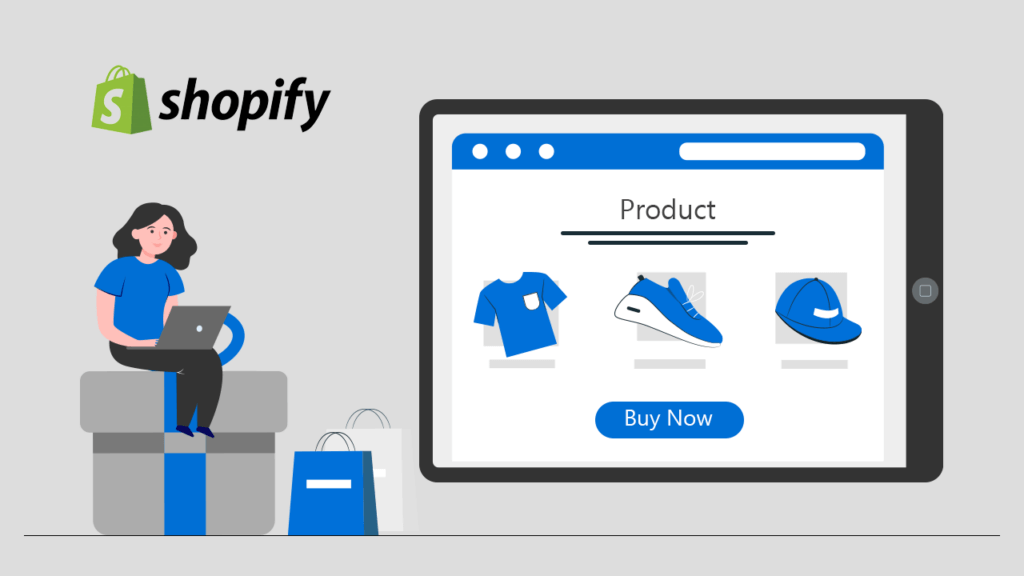“Maximizing Your Sales Potential: Tips for Creating a Custom Shopify Product Page That Converts”
Are you tired of using the same old Shopify product page templates as everyone else? Do you want to stand out from the competition and create a custom product page that genuinely reflects your brand and products? Look no further! This comprehensive guide will walk you through the step-by-step process of creating a custom Shopify product page template to help you achieve your e-commerce goals.
Part 1: Understanding the Importance of Custom Product Page Templates
- Stand out from the competition: A custom product page template allows your e-commerce store to stand out and give customers a unique and memorable experience. By customizing your product page’s layout, design, and functionality, you can differentiate your brand and create a more engaging and visually appealing product page.
- Better user experience: A custom product page template can help improve customers’ experience by making navigating and finding the information they need easier. Custom features such as size or color options, product videos, or customer reviews can help customers make more informed purchase decisions.
- Increased conversion rates: By providing a better user experience and making it easier for customers to find and purchase products, a custom product page template can increase conversion rates and sales for your e-commerce store.
- Branding consistency: A custom product page template allows you to align your product page with your brand’s visual identity and messaging. This can help create a more cohesive and consistent brand experience for customers across all touchpoints.
- Flexibility and scalability: A custom product page template allows you to adapt your product page to your changing business needs and goals. As your e-commerce store grows and evolves, you can change and add new features to your product page template to better serve your customers.
Part 2: Preparing Your Shopify Store for Customization
- Choose a Shopify theme: Shopify offers a wide range of pieces that can be used as a starting point for customizing your product page. Choose an amount that aligns with your branding and provides the functionality and features you need for your e-commerce store.
- Make a backup of your theme: Before making any changes to your music, it’s essential to create a backup so that you can restore it if needed. This can be done by going to the Shopify admin dashboard and clicking Online Store > Themes > Actions > Duplicate.
- Please familiarize yourself with Liquid: Liquid is the templating language used by Shopify, and it’s essential to understand how it works to customize your product page. You can learn more about Liquid using Shopify’s documentation and tutorials.
- Identify the product page template: To customize your product page, you must identify the template that controls how your product pages are displayed. This can typically be found by going to the Shopify admin dashboard and clicking on Online Store > Themes > Actions > Edit Code > Templates > Product. Liquid.
- Create a development environment: It’s essential to create a development environment where you can safely make and test changes to your theme without affecting your live e-commerce store. This can be done by duplicating your music and changing the same article.
Part 3: Customizing Your Shopify Product Page Template
- Understand the Shopify Liquid templating language: Liquid is the templating language used by Shopify, and it’s essential to understand how it works to customize your product page template. You can learn more about Liquid using Shopify’s documentation and tutorials.
- Customize the product page layout: The layout of your product page can considerably significantly affect customer experience. Consider customizing the design to showcase your products better and make it easier for customers to navigate and find the information they need.
- Add custom product page features and functionality: Depending on your needs, you may want to add custom features and functionality to your product page. This can include adding social media sharing buttons, product videos, or custom product options such as size or color variations.
- Optimize your product page for SEO: Optimizing your product page for search engines can help improve its visibility and drive traffic to your e-commerce store. Make sure to include relevant keywords in your product title, description, and other content, and use structured data to help search engines understand the content of your page.
- Use a page builder app: If you’re uncomfortable with coding, you can use a page builder app to customize your product page template. These apps allow you to easily create custom product pages using drag-and-drop interfaces and pre-built templates.
Part 4: Testing and Launching Your Custom Product Page
- Test your product page on multiple devices and browsers: Make sure your custom product page is responsive and works well on different devices and browsers. Test it on desktop computers, laptops, tablets, and smartphones to ensure it looks and functions as expected.
- Test your product page with different product variations: If your product page includes custom product options such as size or color variations, ensure each variation works as expected and is accurately reflected in the product price and other details.
- Test your product page with different payment and shipping methods: If you have customized your checkout page, ensure that each payment and shipping method works correctly and that the customer is charged the correct amount for each order.
- Check for errors and bugs: Thoroughly test your product page for any errors or bugs that may affect its functionality or appearance. This can include broken links, missing images, or formatting issues.
- Get feedback from others: Ask friends, family members, or colleagues to test your product page and provide feedback on its design and functionality. This can help you identify any issues that you may have missed and improve the user experience for customers.
Part 5: Advanced Customization Techniques
- Adding custom product options: Shopify allows store owners to add custom product options to their product pages, such as dropdown menus or checkboxes for selecting color, size, or other product variations.
- Creating a custom checkout page: Shopify’s checkout page is also customizable, allowing store owners to create a checkout page that aligns with their branding and provides a seamless user experience for customers.
- Integrating third-party apps and services: Shopify has a vast app store that offers a wide range of third-party apps and services that can be integrated into the product page to add advanced functionality.
- Using product page templates: Shopify also offers product page templates that can be used as a starting point for customizing a product page. These templates provide pre-built layouts and designs that can be easily modified to fit the store’s needs.
- Using custom code: For more advanced customizations, store owners can also use custom code to modify the product page. Shopify’s Liquid templating language allows for advanced customization options, such as adding custom sections, changing the product page layout, or adding custom functionality.
Conclusion
In conclusion, a Shopify product page is a crucial element of any e-commerce store, as it is the main point of interaction between the customer and the product. Customizing your Shopify product page can significantly impact customer user experience, conversion rates, and overall sales for your e-commerce store.
By understanding the importance of custom product page templates, preparing your Shopify store for customization, and utilizing advanced customization techniques, you can create a truly unique and functional custom Shopify product page that provides a seamless user experience for customers and helps drive sales and revenue for your e-commerce store.
Remember to test and launch your custom product page only after thorough testing and promotion through your marketing channels. By following these best practices, you can create a custom product page that stands out from the competition and helps your e-commerce store thrive in a crowded and competitive market.
FAQs
What is a Shopify product page?
A Shopify product page is a web page that displays a specific product or service that is sold through an e-commerce store powered by Shopify. It typically includes product details such as price, description, images, and other relevant information, as well as options for customers to select product variants, add the product to their cart, and proceed to checkout.
The design and layout of a Shopify product can vary depending on the theme and customization options chosen by the store owner. A well-designed and optimized product page can help improve the user experience for customers and ultimately lead to higher conversion rates and sales for the e-commerce store.
How to customize the Shopify product page?
A Shopify product page can be customized through the theme code editor, accessed through the Shopify admin dashboard. Here are the steps to customize a Shopify product page:
- Backup your theme: Before making any changes to the theme code, it’s essential to create a backup so that you can restore it if needed.
- Go to the theme code editor: From the Shopify admin dashboard, go to Online Store > Themes, then click on the “Actions” dropdown and select “Edit code.”
- Find the product template: In the theme code editor, navigate to the “Templates” folder and find the “product.liquid” template. This is the template that controls how the product page is displayed.
- Customize the template: Depending on your needs, you can customize various aspects of the product page, such as the layout, colors, fonts, and functionality. You can also add custom sections and elements to the product page.
- Preview and test your changes: Once you’ve made your changes, preview the product page to ensure everything looks and functions as expected. Test the product page on different devices and browsers to ensure it is responsive and user-friendly.
- Publish your changes: Once satisfied, click “Save” and “Publish” to make your changes live on your e-commerce store.
Customizing a Shopify product page requires some knowledge of HTML, CSS, and Liquid, which is Shopify’s templating language. However, many third-party apps and services can help simplify the customization process and add advanced functionality to your product pages.
What is the best Shopify product page?
There is no “best” Shopify product page, as the design and functionality of a product page can vary depending on the specific needs and preferences of each e-commerce store. However, a well-designed and optimized product page typically includes the following elements:
- Clear product title: The product title should be clear, descriptive, and accurately reflect the product being sold.
- High-quality product images: The product page should include high-quality images that showcase the product from different angles and show details such as texture, color, and size.
- Detailed product description: The product description should provide detailed information about the product’s features, benefits, and relevant specifications.
- Pricing information: The product page should display the product’s price, discounts or promotions, and relevant tax or shipping information.
- Add to cart button: The product page should include a prominent and easy-to-use “Add to Cart” button that allows customers to quickly add the product to their cart and proceed to checkout.
- Product Reviews: Including customer reviews and ratings can help build trust and provide social proof for the product.
- Customization options: Depending on the product, the product page may include customization options such as size, color, or material.
- Related products: Including associated products or recommendations can help customers discover other products that may interest them.
In addition to these essential elements, a well-designed product page should be visually appealing, easy to navigate, and optimized for search engines to help improve visibility and drive traffic to the e-commerce store. Ultimately, the “best” Shopify product page effectively showcases the product and provides a positive user experience for customers, leading to higher conversion rates and sales for the e-commerce store.
What is the Shopify custom product page?
A Shopify custom product is a unique product page that has been customized to fit the specific needs and branding of an e-commerce store. Instead of using a standard product page template provided by Shopify, store owners can create a custom product page that showcases their products in a way that aligns with their brand and provides a better user experience.
A custom product page can be created by modifying the code of the Shopify theme used by the store, allowing for greater flexibility in layout, design, and functionality. Some common customizations that can be made to a Shopify product page include:
- Changing the layout and design of the product page to match the store’s branding
- Adding custom product options, such as size or color variations
- Including product videos, 360-degree images, or other interactive elements
- Optimizing the product page for search engines to improve visibility and drive traffic to the store
- Integrating third-party apps and services, such as social media sharing buttons or customer reviews
A well-designed and optimized Shopify custom product can help improve the user experience for customers, increase engagement, and ultimately lead to higher conversion rates and sales for the e-commerce store.





